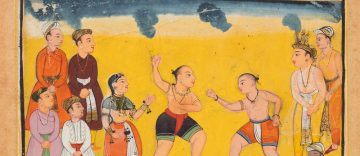 Audrey Truschke in Aeon:
Audrey Truschke in Aeon:
The Mahabharata is a tale for our times. The plot of the ancient Indian epic centres around corrupt politics, ill-behaved men and warfare. In this dark tale, things get worse and worse, until an era of unprecedented depravity, the Kali Yuga, dawns. According to the Mahabharata, we’re still living in the horrific Kali era, which will unleash new horrors on us until the world ends.
The Mahabharata was first written down in Sanskrit, ancient India’s premier literary language, and ascribed to a poet named Vyasa about 2,000 years ago, give or take a few hundred years. The epic sought to catalogue and thereby criticise a new type of vicious politics enabled by the transition from a clan-based to a state-based society in northern India.
The work concerns two sets of cousins – the Pandavas and the Kauravas – who each claim the throne of Hastinapura as their own. In the first third of the epic, the splintered family dynasty tries to resolve their succession conflict in various ways, including gambling, trickery, murder and negotiation. But they fail. So, war breaks out, and the middle part of the Mahabharata tells of a near-total world conflict in which all the rules of battle are broken as each new atrocity exceeds the last. Among a battlefield of corpses, the Pandavas are the last ones left standing. In the final third of the epic, the Pandavas rule in a post-apocalyptic world until, years later, they too die.
From the moment that the Mahabharata was first written two millennia ago, people began to rework the epic to add new ideas that spoke to new circumstances. No two manuscripts are identical (there are thousands of handwritten Sanskrit copies), and the tale was recited as much or more often than it was read.
More here.
